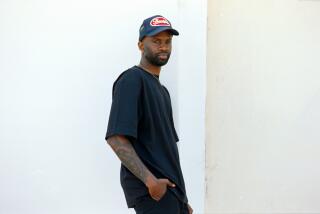WAR PHOTOS STRIKE NOTE OF EMPATHY
LA JOLLA â Morbid fascination is one very human reason to view âJohn Hoagland: Photojournalist,â an exhibit at the La Jolla Museum of Contemporary Art that suggests the human toll of war in Central America.
In this case, the fascination is twin-edged. War-zone photos are typically morbid enough by themselves, but the lure of these shots is compounded by the sad fact that Hoagland died in March--with his boots on. He was scouting a combat situation for a group of 50 reporters in El Salvador when he was hit in the chest by a U.S.-made bullet.
Dead at 37, Hoagland was born in San Diego and established himself as a top photographer for Associated Press, United Press International, the Gamma-Liaison agency and Newsweek magazine. At the time of his death, he had logged more time and shot more film in more parts of Central America than any other American journalist.
But he was no mere Yankee opportunist plundering a war-torn land of its most squalid, saleable images. By 1980, he had moved to El Salvador, where he married a Salvadoran woman who survives him. Hoagland called the country his home.
Knowing all that, one might view Hoaglandâs legacy as that of a Salvadoran who isnât bothering with political distinctions. War is hell, his photos say obviously enough, and keeping clear of its fire is steady work. Other Yankee photographers of the Vietnam and post-Vietnam eras may have come up with more searing images that drip with pathos, cruel irony, or graphic shock, but Hoaglandâs camera struck an empathetic yet unflinching balance.
For example, a portrait of a âguerrilla family in a rebel âzone of controlâ â depicts a young married couple and their toddler son--armed to the teeth with automatic rifles. Their smiles, as captured by Hoagland, are neither sardonic nor sad, but suffused with life and purpose and perhaps an acceptance of chaos that makes a lot of sense under the circumstances. These are not people with whom we have trouble identifying. Hoagland has seen to that.
So it is with most of his photos of citizens and children caught in the middle and making a go of things while larger geopolitical forces shape their destinies. Children glimpsed at the perimeter fence of a San Salvador refugee camp are a portrait of health and hope behind barbed wire. Villagers seen mourning the shrouded corpse of a war victim are without illusions, yet still seem stronger than the forces of despair.
But Hoagland was as ready for the decisive moment of crisis. A shot of Salvadoran national guardsmen arresting a mechanic during a 1980 strike is a tableau of tense geometry, with rifles cocked and soldiers carefully at odds with their kneeling prisoner. A womanâs face distorted by grief at the death of a loved one is standard stuff, but Hoaglandâs respect for the moment strengthens the picture. A shot of civilians fleeing combat in Beirutâs center of town (Hoagland was there briefly in 1984) is as potently kinetic as newsreel footage.
Probably the most pointedly arty shot here is a color photo of a soldier juggling some oranges after a âclean-upâ operation that has left several men dead at his feet. The horror of the image is mitigated by the soldierâs stolen moment of amusement. Without prettying an ugly scene, Hoagland has found both its human signature and a great metaphor for lives juggled by fate.
Fatefully, and maybe fittingly, Hoaglandâs most decisive moment has been tracked by his lens. The last six exposures found in his camera have been printed and are displayed at the end of the show. The first four, shot moments before his death, frame a Salvadoran soldier waving Hoagland ahead of his group. The last two shots are of the ground, swirling up as the bullet brings Hoagland down. Blackness eats at the photos from the right side. It must have seemed a dream of falling, and Hoagland kept his finger on the button. For him, the razorâs edge dividing life and death moved at shutter speed.
More to Read
The biggest entertainment stories
Get our big stories about Hollywood, film, television, music, arts, culture and more right in your inbox as soon as they publish.
You may occasionally receive promotional content from the Los Angeles Times.










